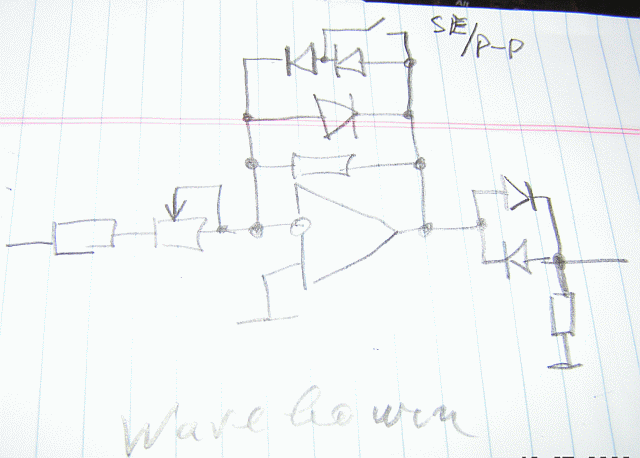Kev
Well-known member
[quote author="mediatechnology"]And where's Kev today?
And PRR to throw cold water on everyone?[/quote]
had big trouble with access yesterday and so have missed your changes
I have a CM simulation going of the pre modified version and although it works ... operates
:roll:
it doesn't simulate they way you wanted it to ... changes R5 to get lower voltages than kilovolts and 10.5K makes U2 approximately unity gain.
a quote from Dad
" From the "x2 or x3 gain power" switch I 'deduce' that the intention was to go "x - log - times two - antilog" expecting to get "x squared" out the far end and, presumably, from "times 3" to get "x cubed". ... but that aint so ..! ?? "
it looks that there could be a misunderstanding with the so-called "log-law" of a PN junction.
It might be that there is a relationship between current through to voltage across that follows a log law but it doesn't perform a squaring operation. ... this a gain controlled amplifier (via the U2 feedback resistor) ?
:roll:
I've rushed the above reply , just in case I have access trouble again so don't pick me up in simple typing/thinking errors or word choices ...
and haven't had time to think about the recent stuff so much but your simulator results could be getting some squaring via headroom/voltage rail effects and so the harmonics
... 'cause our CM model using ideal opamps didn't produce this sort of stuff
for what it's worth and
even though the file is a couple of mods/page old now here is the CM file
http://www.diyfactory.com/data/discussion/Strange.CKT
being in the different time zone and net troubles I probably can't keep up with the thread.
please do look at the simple two operator simulate on my previous post as it highlights the problem of mixing the effect back in with the original.
I feel this is what is wrong with ALL(most) of the saturation style effect units.
To emulate the tube sort of thing I feel that the effect circuit should handle the signal as one signal stream unless the effect stream can have the same phase and group delay.
also I would have liked to spend more time on analysing a distorted waveform to see where and what part of the waveform produces the required sounds we like. I don't think this has ever been done acurately enough before. Also the simulations of Tubes in spice have never been detailed enough to acurately predict the waveform shape of the real thing. Yeah there help to predict that a circuit works but they don't draw the waveform right and so the harmonic predictions are way off.
:sad:
as I've said the simplicity of that two operator mix to simulate a single 2nd harmonic and two very different resultant waveforms say so much about future problems of any simulation or actual completed circuit.
shut up Kev
And PRR to throw cold water on everyone?[/quote]
had big trouble with access yesterday and so have missed your changes
I have a CM simulation going of the pre modified version and although it works ... operates
:roll:
it doesn't simulate they way you wanted it to ... changes R5 to get lower voltages than kilovolts and 10.5K makes U2 approximately unity gain.
a quote from Dad
" From the "x2 or x3 gain power" switch I 'deduce' that the intention was to go "x - log - times two - antilog" expecting to get "x squared" out the far end and, presumably, from "times 3" to get "x cubed". ... but that aint so ..! ?? "
it looks that there could be a misunderstanding with the so-called "log-law" of a PN junction.
It might be that there is a relationship between current through to voltage across that follows a log law but it doesn't perform a squaring operation. ... this a gain controlled amplifier (via the U2 feedback resistor) ?
:roll:
I've rushed the above reply , just in case I have access trouble again so don't pick me up in simple typing/thinking errors or word choices ...
and haven't had time to think about the recent stuff so much but your simulator results could be getting some squaring via headroom/voltage rail effects and so the harmonics
... 'cause our CM model using ideal opamps didn't produce this sort of stuff
for what it's worth and
even though the file is a couple of mods/page old now here is the CM file
http://www.diyfactory.com/data/discussion/Strange.CKT
being in the different time zone and net troubles I probably can't keep up with the thread.
please do look at the simple two operator simulate on my previous post as it highlights the problem of mixing the effect back in with the original.
I feel this is what is wrong with ALL(most) of the saturation style effect units.
To emulate the tube sort of thing I feel that the effect circuit should handle the signal as one signal stream unless the effect stream can have the same phase and group delay.
also I would have liked to spend more time on analysing a distorted waveform to see where and what part of the waveform produces the required sounds we like. I don't think this has ever been done acurately enough before. Also the simulations of Tubes in spice have never been detailed enough to acurately predict the waveform shape of the real thing. Yeah there help to predict that a circuit works but they don't draw the waveform right and so the harmonic predictions are way off.
:sad:
as I've said the simplicity of that two operator mix to simulate a single 2nd harmonic and two very different resultant waveforms say so much about future problems of any simulation or actual completed circuit.
shut up Kev


































